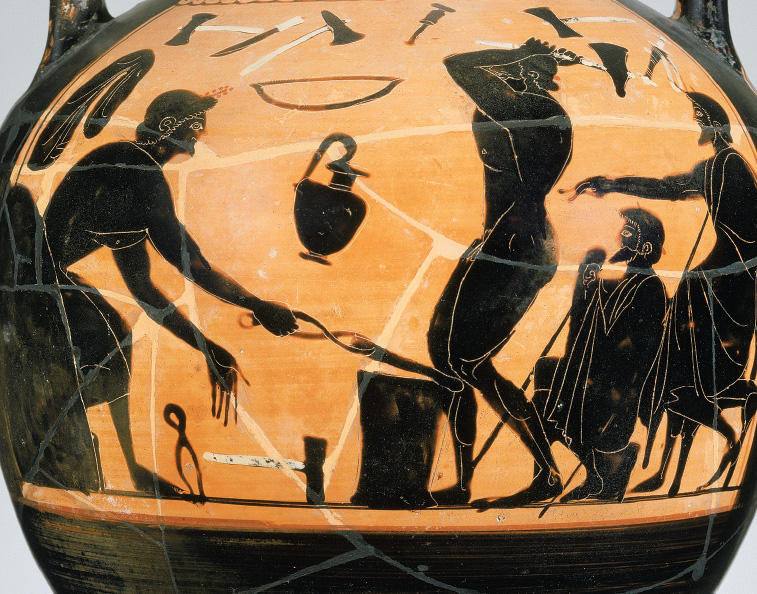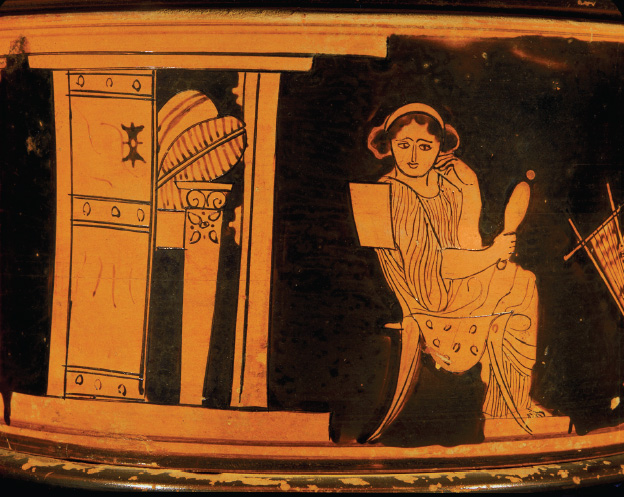A History of Western Society: Printed Page 81
A History of Western Society, Value Edition: Printed Page 83
Households and Work
In sharp contrast with the rich intellectual and cultural life of Periclean Athens stands the simplicity of its material life. The Athenians, like other Greeks, lived with comparatively few material possessions in houses that were rather simple. Well-to-do Athenians lived in houses consisting of a series of rooms opening onto a central courtyard, sometimes with bedrooms on an upper floor. Artisans often set aside a room to use as a shop or work area. Larger houses often had a dining room at the front where the men of the family ate and entertained guests at drinking parties called symposia, and a gynaeceum (also spelled gynaikeion), a room or section at the back where the women of the family and the female slaves worked, ate, and slept. Other rooms included the kitchen and bathroom. By modern standards there was not much furniture. In the men’s dining room were couches, a sideboard, and small tables appropriate for social events. Cups and other pottery were often hung from pegs on the wall, as were hoplites’ armor and, for aristocrats, the death masks of their relatives. In the courtyard were the well, a small altar, and a washbasin. If the family lived in the country, the stalls of the animals faced the courtyard. Country dwellers kept oxen for plowing, pigs for slaughtering, sheep for wool, goats for cheese, and mules and donkeys for transportation. Even in the city, chickens and perhaps a goat or two roamed the courtyard along with dogs and cats.

Cooking, done over a hearth in the house, provided welcome warmth in the winter. Baking and roasting were done in ovens. Meals consisted primarily of various grains, especially wheat and barley, as well as lentils, olives, figs, grapes, fish, and a little meat, foods that are now part of the highly touted “Mediterranean diet.” The Greeks used olive oil for cooking, and also as an ointment and as lamp fuel.
The Greeks did not eat much meat. On special occasions, such as important religious festivals, the family ate the animal sacrificed to the god. The only Greeks who consistently ate meat were the Spartan warriors. They received a small portion of meat each day, together with the infamous Spartan black broth, a concoction of pork cooked in blood, vinegar, and salt. One Athenian, after tasting the broth, commented that he could easily understand why the Spartans were so willing to die.

In the city a man might support himself as a craftsman — a potter, bronze-smith, sailmaker, or tanner — or he could contract with the polis to work on public buildings. Certain crafts, including spinning and weaving, were generally done by women, who produced cloth for their own families and sold it. Men and women without skills worked as paid laborers but competed with slaves for work.
Slavery was commonplace in Greece, as it was throughout the ancient world. Slaves were usually foreigners and often “barbarians,” people whose native language was not Greek. Most citizen households in Athens owned at least one slave. Slaves in Athens ranged widely in terms of their type of work and opportunities for escaping slavery. Some male slaves were skilled workers or well-educated teachers and tutors of writing, while others were unskilled laborers in the city, agricultural workers in the countryside, or laborers in mines, including the Athenian silver mines at Laurium. Female slaves worked in agriculture, or as domestic servants and nurses for children. Slaves received some protection under the law, and those who engaged in skilled labor for which they were paid could buy their freedom. A few ex-slaves even became Athenian citizens. (See “Primary Source 3.5: Aristotle on Slavery.”)